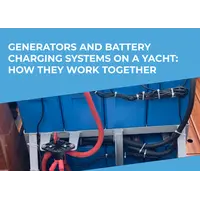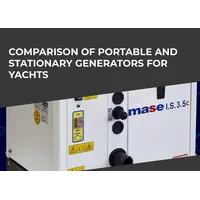topRik's experts - constantly practicing yachtsmen - compare the two main types of inflatable boats. But it is you who will have to make the final choice between an inflatable dinghy with a soft or hard bottom, or a fully rigid hull. To facilitate this choice, our experts describe in detail the advantages and disadvantages of these two main types of boats in all their varieties, depending on their purpose and use.
Introduction
Keep in mind that the choice of the boat depends on the purpose, intended by the manufacturer, as well as your own requirements. If you think about it carefully, you will understand that there is a difference, and a significant one. All tender boats are designed to disembark after launched into the water at anchorage, but not all of them are able to overcome the surf line or cope with the ebb current.
That's why before buying an inflatable dinghy or rigid dinghy it's so important to decide when and in what areas it will be used.
This should also be done in cases where you are not going to use the boat as a dinghy for a yacht. If you need a boat for water trips in sheltered waters, it can be any inflatable boat of a suitable carrying capacity, including rowing ones if you want to warm up.
But if you need a boat for fishing or hunting in such areas, choose an inflatable motorboat with a hard bottom or a hard hull so that you can move around in it without fear of experiencing the “trampoline effect”, which is typical of a soft bottom.
If the dinghy on the yacht will also be used for diving or spearfishing, think about how your equipment can damage the inflatable bottom.
Some boating water sports (water skiing, etc.) require it to be equipped with powerful motors, which can only be installed on a large reliable transom.
Therefore, before you make a purchase, carefully study the planned route of your yacht. Find out about the state of the water area in the places of possible anchorage near the ports and marinas that you plan to visit. Get reliable information about the coastline of the islands you want to explore. List on paper or in a file all the features that you want to put on your future inflatable dinghy or rigid dinghy .
The same analysis is necessary for those who choose a boat for any other purpose. Focus on the basic rule: the use of your dinghy must comply with its intended use, as indicated in the instructions, taking into account the CE certification, dimensions, load capacity and number of seats.
So, we will assume that you have been conscientious about ensuring the safety of the passengers of your future boat and clearly know what under what conditions it will perform. Now is the time to understand in detail all the dinghy options.
The market offers a huge number of them, so it is important to cut off the excess to avoid overpaying. But the necessities still should not be neglected in order to achieve the goal of a purchase without sacrificing safety for everyone on the boat in the process.
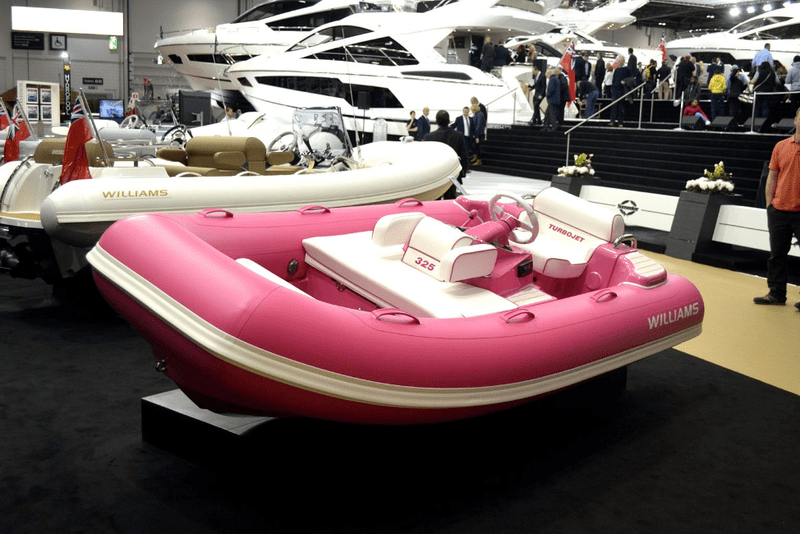
Description of Inflatable Boats
It should immediately be noted that inflatable boats include a large group of models that differ in the design of the bottom and even the presence of a rigid hull. We will describe the latter in the next section, dedicated to rigid inflatable boats (RIB). Now we will limit ourselves only to those models that do not have a hull as such, since they consist of inflatable chambers located along the perimeter of the bottom (possibly with a keel) and separated by a transom to which the board for the engine is attached.
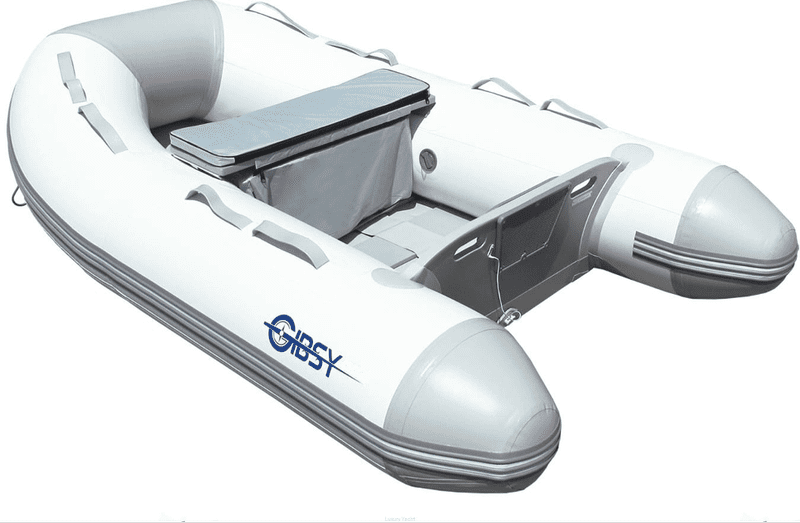
Features and Benefits
A common feature of all inflatable boats (including rigid hulled inflatable boats) is the presence of large diameter inflatable chambers isolated from each other. Depending on the size of the boat, there may be a different number of them, but two - for sure, even in the smallest ones. This gives an additional opportunity to stay on the water surface and reach the shore if the bottom or one of the chambers is damaged.
The higher the number of chambers and their diameter, the better the stability of the boat and its reliability.
The main materials used for inflatable chambers, keels and bottom are PVC, neopren and hypalon. These materials are resistant to ultraviolet and sea salt, temperature changes, friction and other types of mechanical stress. All of these materials are polymers: PVC is a plastomer, neopren and hypalon are elastomers. This difference in the manufacturing process and the internal structure of the materials determines the degree of their quality characteristics.
For example, hypalon outperforms the other two materials in UV resistance, so boats with hypalon chambers are highly desirable when visiting the tropics. But if you choose a 5-layer PVC dinghy, you won't go wrong with its longevity either. You won't win in terms of price though. Neopren is the perfect compromise between inexpensive but short-lived low-layer PVC and the most resistant to all negative influences, but expensive hypalon.
The main advantage of inflatable dinghies is the ease of their transportation and storage options. All these models take up very little space when disassembled and deflated. This is especially true for boats with inflatable and slatted floors. After deflating the boat, such a floor often does not even need to be removed to roll it up. Models up to 4 meters long, even with an inflatable keel, after folding, are placed in a special bag and car trunk. Of course, benches, oars and the engine should be removed, stored and transported separately from the "body" of the boat.
These models are so light that even when inflated and with benches, they can be transported on the roof of a large car or motorhome. In this case, it is also better to remove the engine, just so as not to damage the car.
Their lightness and low draft, even when fully loaded, make it possible to use such boats in shallow water, coming close to shallows, which is impossible to do on a yacht, or when hunting in the reeds, if such a boat has a rigid hull.
Another advantage is that the materials from which inflatable boats are made can be washed using the most affordable and cheap means, up to ordinary soap.
Overview of Various Models and Designs
Most inflatable dinghies can be divided according to the design of the bottom, if, as we specified above, with rigid inflatable boats being an exception.
topRik marketplace offers all types of inflatable models, which are represented by boats with the following varieties in floor construction:
- Slatted floor. These boats are of various sizes and carrying capacities with various numbers of large diameter chambers, in which the floor is made of slats laid in a special way - marine plywood, polymers or aluminum alloy are used as main materials for it. This design provides rigidity to the floor, reduces the trampoline effect and makes boarding and disembarking safe for passengers.
- Inflatable air floor. These boats also differ in the size, number and diameter of the chambers, but have a common floor design of two varieties: low-pressure floor and high-pressure floor. Boats with a low-pressure floor can be used for boat trips in sheltered waters or for fishing and hunting in the same area. Remember that in such boats, movement should be kept to a minimum and boarding and disembarking should be carefully controlled, since there is a risk of losing balance.
A high-pressure floor is close to a hard floor in its properties - it practically does not have the trampoline effect, allowing you to move inside the boat without the risk of falling.
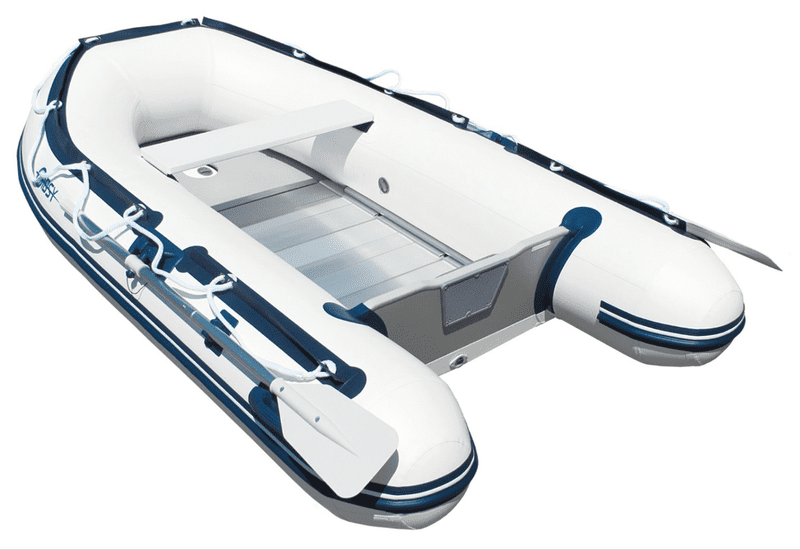
There are also models with flooring made of a solid sheet of plywood – veneer base or payol. These are rather bulky and heavy floorings, which are typical for outdated rubber models. They are difficult to install, and if installed incorrectly, the floorboards can abrade the material of the floats.
Often such floors are made independently in order to install them in rubber inflatable boats without any flooring. The bottom of such boats is just a sheet of PVC glued to the inflatable chambers. We consider such a boat somewhat dangerous for use for any purpose in all types of waters. But, of course, the opinion of our experts may not coincide with yours.
Depending on the presence of a keel, inflatable boats can be keeled and keelless. Moreover, models with a rigid bottom and a high-pressure inflatable floor can have both a rigid and an inflatable keel, and models with a low-pressure floor can have an inflatable keel also.
Scope and Where Are Commonly Used
Once again, we remind all lovers of water recreation that the scope of inflatable boats is indicated in the manual. Sticking to it is a guarantee of boat passengers’ safety. First of all, we pay attention to the design certification in the CE system. This gives you the first usage limit. Typically, the area of use of such boats is limited to closed water vodies and coastal waters.
Based on this, we also determine the possible scope of use of inflatable dinghies:
- transportation of passengers and cargo between the anchored yacht and the berth of the port, marina or some not equipped shallow shore;
- boat trips around the yacht at anchorage or in coastal waters, as well as in closed water bodies;
- as a means of moving passengers and equipment from the yacht to the location for diving, fishing, spearfishing;
- fishing or hunting for water game.
Description of Rigid Inflatable Boats
Rigid inflatable boats (RIBs), also called rigid hulled inflatable boats (RHIBs), were originally invented for highly specialized purposes. They were developed in the UK for the Navy and the Water Rescue Services.
Features and Benefits
The purpose of the RHIB, or RIB, dictates its design: the combination of a low rigid hull (mostly the bottom) and sides with very large diameter buoyancy chambers.
The keel in such models can be made of the same material as the hull, or it can be inflatable - the rigid base of the bottom allows this option. But RIB can also be keelless, which somewhat reduces its resistance to oncoming waves, and as a result, speed and maneuverability.
A reliable transom is an essential part of the RIB design, since these types of boats are usually equipped with high-power engines. Therefore, the transom must be made of plywood or metal, and the motor frame must be made of metal.
The body of the RIB can be made of metal or polymeric materials - fiberglass, carbon fiberglass, laminate.
The inflatable elements also use rubberized neoprene or polyester fabric with several layers of PVC, as well as the new hypalon material. The number of air chambers in the RIB depends on the size of the boat and starts with three pieces - a central one and two side ones.
By the way, when choosing dimensions in accordance with the place of storage on a yacht or indoors, remember that RIB dimensions are calculated at the extreme points of the sides. Therefore, do not be surprised that even with increased dimensions, the number of seats doesn’t differ much from other inflatable boats of the same size.
Rigid hulled inflatable boats have received all the advantages of conventional rigid and inflatable boat models at the same time. So in order to save you time reading, let's just add to the advantages of conventional inflatable boats, which were listed in the previous section, the advantages that come from a rigid hull.
- The rigid hull doesn’t weigh the boat enough to affect the draft when compared to models of the same length. But it significantly increases their carrying capacity, especially if you take into account the increased diameter of the floats.
- The diameter of the onboard buoyancy chambers directly affects the stability of the boat during side waves, as well as the buoyancy reserve - all the passengers can reach the shore even with all the chambers deflated. So, never forget about the oars!
- The lightness, deadrise of the hull and the presence of a keel provide high speed qualities, course accuracy, fast speed gain when planing, as well as avoiding pitching and water surface impacts.
- Fast acceleration allows you to use a low-power engine and, as a result, reduce fuel consumption.
- The hard floor does not sag when boarding, disembarking and moving inside the boat. It allows you to actively move while fishing, take a shot while hunting without fear of recoil, safely dive from the side of the boat, etc.
- Inflatable sides act as fenders, so when mooring to a pier, another vessel or your own yacht, the crew is not in danger.
There are inflatable superboats for private owners currently produced, that are created according to the principles of RIB with a rigid bottom, large living areas and even a cabin.
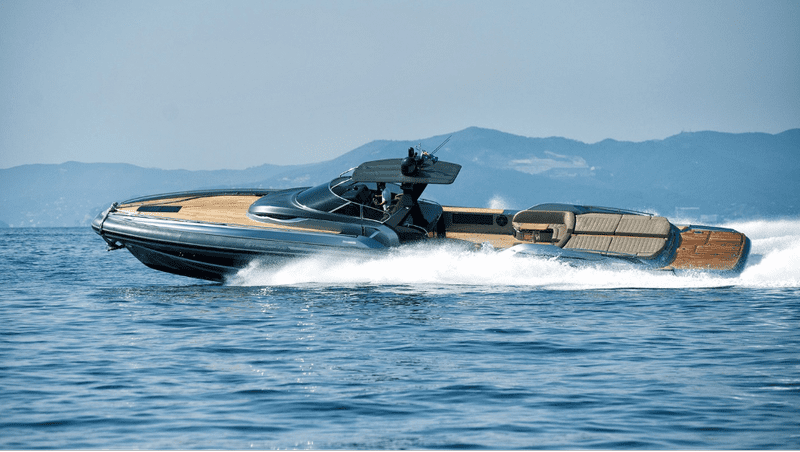
Overview of Different Types of Rigid Boats
Rigid inflatable boats are divided into several subspecies depending on the materials used. We described the materials for air chambers in the previous section - all that information is also valid for RIB.
But there is also a differentiation of RIBs by the material of the hull. Usually fiberglass, metal alloy, polymeric materials are utilized.
Fiberglass sandwich is one of the most popular materials that the leading manufacturers of modern dinghy models use to make their hulls. This design is resistant to mechanical stress, sea salt, decay, ultraviolet radiation and temperature extremes. In addition, fiberglass resists osmosis quite well, although it cannot be compared with the resistance of aluminum alloys in that regard.
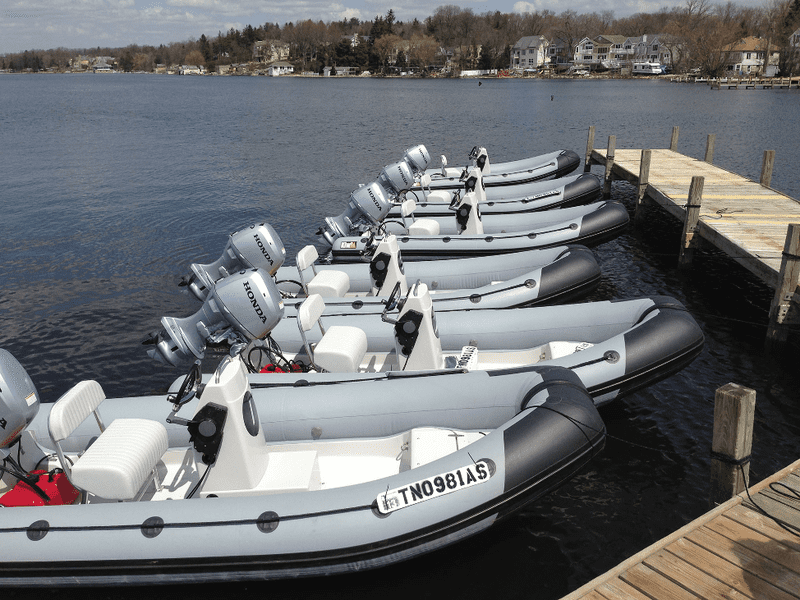
Aluminum alloys with magnesium, in addition to special strength, provide the hull with resistance to corrosion, and RIB as a whole - with excellent cutting of the water mass. This is an almost eternal material that is not afraid of exposure to moisture, including salt, osmosis and other weather negatives. The aluminum alloy body is the most reliable and lightweight, which has a positive effect on maneuverability, according to the practical experience of our experts. But the cost of this splendor might make you return to plastic or polymers.
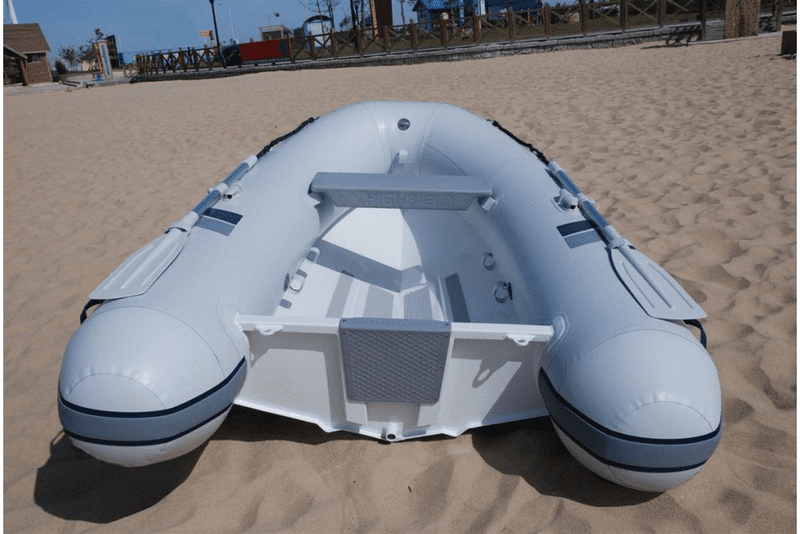
HDPE, or high-density polyethylene is an under-researched low-pressure polymer material. It is also called by the name of the technology - low-pressure polyethylene. Manufacturers claim that it gives the case additional properties to increase resistance to moisture, salts, ultraviolet radiation, decay, and mechanical stress.
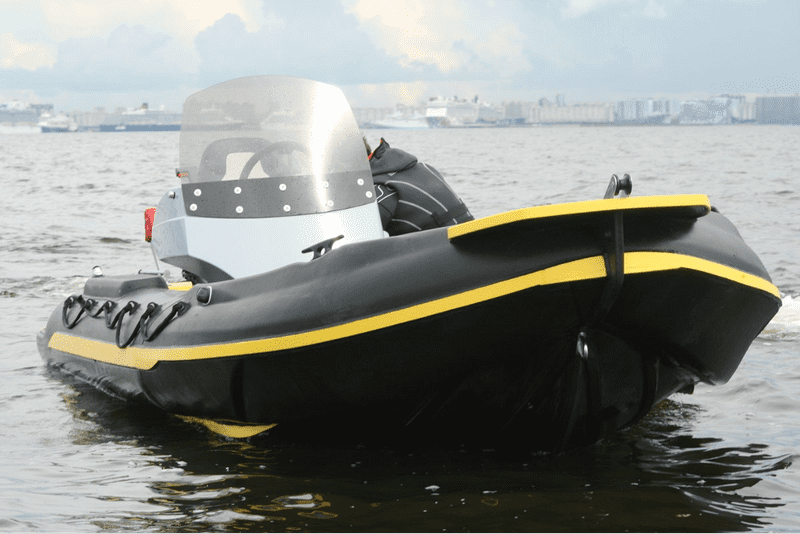
Scope and Common Usage Cases
The rigid hull of the RIB adds new areas of application to the usual ones for inflatable boats with slatted and inflatable floors.
Due to the shallow draft and the durable material of which the hulls are made, these boats are not afraid of shallows, rapids and snags. Due to their light weight and hard bottom, RHIBs are great for hunting in reeds or landing on rocky shores, as well as for traversing rapids on rough rivers.
For the hard bottom of the RIB even hunting or fishing gear scattered along the bottom, diving and spearfishing equipment, as well as the claws of a hunting dog, are not dangerous.
Of course, this is an excellent choice for a tender boat for a yacht, both for transporting people and goods while anchored, and for boat trips in coastal waters, as long as the RIB is rated C in the CE system.
| Hull and chambers material | Density, g/cm³ | Weight of 1 м³, kg | UV resistance | Abrasion and impact resistance | Life time | Price |
|---|---|---|---|---|---|---|
| Aluminium alloy | 2.7 | 2700 | Doesn't affect in any way | Resistant | 15 years | High |
| Fiberglass | 0.4-1.8 | 1100 | Depends on coverage | Resistant | 10 years | Low |
| HDPE | 0.95-0.96 | 950 | Virtually no effect | No time-tested data | No time-tested data | Medium |
| PVC | High | 10 years | Low | |||
| Neopren | High | 15 years | Medium | |||
| Hypalon | Very high | Up to 30 years | +20-60% to PVC cost |
Choice Factors
It all depends on what you are primarily guided by when purchasing any product - quality or cost. Just remember that a boat in any body of water is a factor of increased risk to the health and life of passengers. Therefore, we recommend choosing quality first, and then, based on the planned spending, reduce the requirements to the possible limits. Moreover, these limits should not only be dictated by a certain sum of money available, but by the requirements of the operating instructions.
If you are unable to spend as much as required for the most inexpensive boat with parameters that suit its future functions (certification, cargo capacity, passenger capacity, etc.), then it is better to postpone the purchase. It's not worth the risk of buying a boat that has a sheltered water design certificate for use in coastal waters.
Be guided by the parameters of the yacht, if you choose a tender. There should be enough space at least in lockers to store the boat rolled up.
And one more of the main factors that we have already written about is the characteristics of the water area where you plan to boat.
Comparison of Cost and Service
The most expensive will be a rigid inflatable boat with an aluminum hull and hypalon floats. In this category, the cost will vary depending on the size of the boat and the power of the motor.
Keep in mind that a boat with a high capacity also requires a more powerful motor, and if you are going to do water skiing and similar exercises on the water, the motor must be even more powerful.
Maintenance of a fiberglass hull requires more time - therefore, the cost will be higher than that of an aluminum hull. So, think twice before dismissing an expensive aluminum alloy case.
Specific Examples and Testimonials
In their reviews, topRik experts usually cite the opinions of various authorities in the yachting business, as well as those who have extensive practical experience in the topic covered. Let's not break out traditions - but this time a little surprise awaits you...
Conclusion
We hope that after reading this review, you will be able to choose an inflatable boat, which will meet all your needs without ignoring the manufacturer’s instructions.
For this to coincide, we have considered almost all types of inflatable dinghies and rigid dinghies in their varieties, depending on the design, material used for buoyancy chambers and hulls. We have also listed the advantages of these types of boats and their scope depending on the design, shared our recommendations, compared the costs of the materials and introduced you to other opinions in yachting media.
We hope all this helps you make the right choice. And if you have any questions, you can always contact topRik marketplace experts for a free consultation. You can contact our specialists from this page: call, using the phone above, send an e-mail or use the quick feedback system. Good luck!





